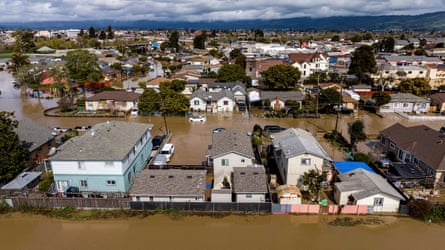Californians are bracing for the arrival of another “atmospheric river” storm on Monday after a weekend of heavy rainfall and flooding forced thousands to evacuate, washed out roads and knocked out power.
Rains are expected to ramp up on Monday night, and “impact increasingly sensitive portions of central California that were hit hard by the rainfall on Friday and early Saturday”, according to the national weather prediction center.
Among areas hardest hit over the weekend were riverfront communities in central California where numerous streams engorged by runoff of rain and melting snow from surrounding mountains were transformed into raging torrents.
Quick glossary of extreme weather terms
ShowA short glossary of the storms and their elements lashing the previously parched state.
Atmospheric rivers: Long streams of moisture - or, as the National Oceanic and Atmospheric Administration simply says, “rivers in the sky” - that transport water vapor from the tropics, after warm water evaporates off the Pacific. They can at times be incredibly destructive, often accompanied by strong, gusty winds.
Pineapple express: A particularly strong system, the pineapple express delivers moisture from around Hawaii to the west coast that then hammers other regions of the US and Canada with rain and snow.
Bomb cyclone: These low-pressure storm systems help create atmospheric rivers, pushing them from the Pacific to the coast. Unlike hurricanes or other storms where the center is the strongest, bomb cyclones can generate the worst weather at their edges.
La Niña: This is a climate pattern characterized by a colder-than-average sea surface level in the Pacific Ocean near the equator. The region is in the grip of a third year of La Niña conditions, which tend to steer storms north into Washington and Oregon.
- Gabrielle Canon
As the latest storm moves in, “it’s not going to take a whole lot of precipitation to result in immediate runoff and rises on rivers and streams, and flooding in urban areas”, said UCLA climate scientist Daniel Swain.
More than 8,500 people were forced to evacuate after the Pajaro River’s levee ruptured on Friday. Fifty people were rescued as floodwaters inundated farmland and agricultural communities.

Efforts to stop the flooding are being complicated by the second atmospheric river, officials said. Many of those displaced were migrant farm workers who do not qualify for federal disaster assistance. “Over 20,000 acres of agricultural lands in Monterey county will now sit fallow due to storm water contamination,” said Luis Alejo, chair of the Monterey county board of supervisors, “causing significant job losses and an impact on our nation’s food supply”.
The Salinas River to the south also overflowed, triggering even more evacuations on Monday morning. The water gushed through residential streets, flooded businesses and inundated parts of California’s famed coastal Highway 1.
The storms also caused flooding, rockslides and avalanches in northern Nevada, which is expecting more damage in the coming days. Governor Joe Lombardo expanded an emergency declaration to include northern regions, as well as a number of other counties, urging “all Nevadans to stay safe, travel cautiously, and to follow all local guidance throughout the continuation of this severe weather”.
“Now’s the time to rush any preparations to completion before conditions go downhill later today,” warned the National Weather Service. The agency has issued more than 30 flood watches across the state.
Heavy, wet snow is expected to hit higher-elevation areas still clogged with piles of snow after a spate of blizzards, and could cause roof collapses, authorities have warned.

The San Bernardino county sheriff’s department said it was investigating what role, if any, late-February snowstorms may have played in the demise of at least eight people, most of them elderly, found to have died alone while snowbound in their homes over the past two weeks.
The last blast of heavy showers and gusty winds arrived on Thursday night and peaked early Friday, sweeping a vast region that is home to about 26 million people, including greater Los Angeles, the San Francisco Bay area and metropolitan Sacramento.
Joe Biden declared an emergency in California, ordering federal assistance to help state and local authorities cope with the severe weather.
The coming storm is the product of what meteorologists call an atmospheric river, a high-altitude current of dense, subtropical moisture streaming into the west coast from the warm Pacific waters around Hawaii. It is the 11th such weather system to hit California this season, adding to an exceptionally wet, snowy winter in a state that in recent years has been plagued far more by drought and wildfires than by severe precipitation.
The growing frequency and intensity of such storms amid bouts of prolonged drought are symptomatic of human-caused climate change, experts say. The swing from one extreme to another has increased the difficulty of managing California’s precious water supplies while minimizing flood and wildfire risks.

About 2,000 residents were under evacuation orders and warnings in San Luis Obispo county, as crews there spent the day monitoring levees, creeks and rivers and filling sandbags, said Rachel Monte Dion, the county’s emergency services coordinator.
Some personnel spent hours in trailers watching for flooding in low-lying areas across the county, which was pummeled by heavy downpours in January, causing a levee to fail and damaging homes.
“Since January, it’s been raining steadily here and so our ground is fully saturated and our creeks are full,” Dion said, adding that flooding on Friday struck parts of the coastal wine country town of Cambria and the beachfront community of Oceano.
In Santa Cruz county, another road washed out by a flooded creek near the town of Soquel left at least 400 homes in adjacent foothill and mountain communities isolated, county spokesperson Jason Hoppin said.
The Tulare county sheriff has issued evacuation orders and warnings for several areas where rivers and streams had either overrun their banks, were nearing dangerously high levels or where a levee was breached. At least one bridge was reported washed out.

 1 year ago
104
1 year ago
104










 English (US)
English (US)